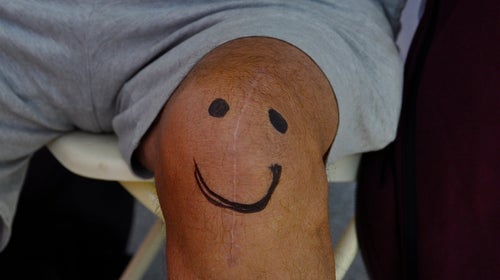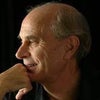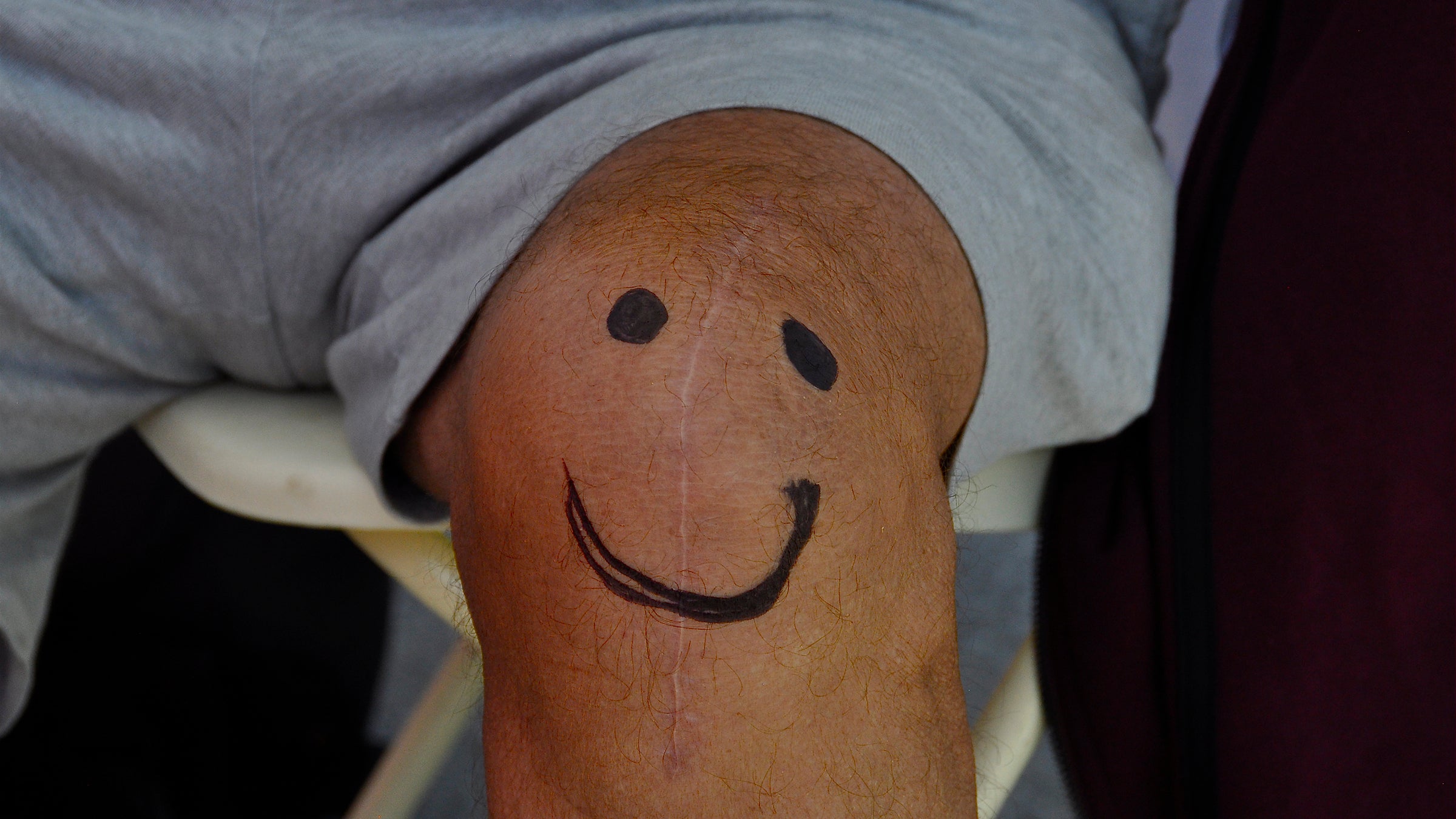The Quest: After competing at open international level, Roger Robinson won World Masters gold medals at age 40 and 50. Now age 81, running on two knee replacements, he had hoped to compete one more time at the World Masters Association Championships, but like the rest of the world, found himself with only virtual races, though still pushing for progress. For a comeback in running on two knee replacements, what is possible? What can other runners with knee problems learn from this journey along an unknown road?
The Interview
Podium Runner: A special welcome to Russell and Mark, two celebrities in the running world, for the world’s first-ever live media conference with two knee replacements—half-brothers, colleagues, and sometimes rivals. Please tell us first about your origins. Russell, you’re the older, would you like to go first?
Russell: I’m a New Zealand Partial Knee Arthroplasty, PKA, which means only part of the knee is removed. I’m named in honor of Dr. Russell Tregonning, who implanted me in Roger’s right leg in January 2011. I’m a special kind of partial called Oxford Unicompartmental Replacement. I’m made of molded polyethylene, glued in place.
Roger had bone on bone pain for fifteen years; he finally couldn’t run a step and walked only with pain. Dr. Tregonning said that the degree of cartilage loss made it a marginal decision between partial and total replacement, but during the surgery, he found that Roger’s ligaments (anterior and posterior) were so strong from his lifetime of running, and recent cycling, that the less drastic partial would work. So far, there has been no further pain in the right knee. And X-rays show no wear on me from the running.

Russell and Dr. Russell Tregonning, 2016
Mark: I’m American, I’ll be three years old in August, and I’m named in honor of Dr. Mark Aierstok, of Orthopedic Associates of Dutchess County, in New York State, where Roger was living when his left knee suddenly gave extreme pain in late 2016. This followed two years of hard and successful age-group racing, on Russell and one natural knee whose cartilage must have been worn, like an old tire that you don’t know is thin until it punctures. It was mere shreds, in fact. This time, a total replacement (TKA) was inevitable. Like Russell, I’m made of polyethylene, with cobalt chrome, and in my procedure the ligaments did have to be cut. I’m surgically a much bigger deal. So, if you’re contemplating getting one of us, make sure you discuss all options, and choose a surgeon who understands that renewed running is a priority for you.
PR: Tell us about the first stages of recovery.
Mark: The recovery process was pretty similar for both of us, probably because surgical techniques had progressed between 2011 and 2017, like how they now peel back skin layer by layer to reduce the severity of incisions. And Roger was well motivated both times to get active, setting records round the furniture on his crutches or walker, and then along the street. The prescribed drugs were an issue, after my more serious total procedure. After three days Roger talked to his doctor and cut out the heavy opiates, not convinced by the medical mantra “stay ahead of the pain.” An elite runner is used to handling pain, and being semi-comatose all day seemed much worse.
PR: When did you first start to run?
Russell: Dr. Tregonning in 2011 wisely advised against impactive exercise, but after three months of slowly increased walking and cycling, Roger “sort of forgot,” as he puts it, and tried a little running, just ten paces to begin with. Four months after the surgery, he was jogging fifteen minutes in the course of a two-hour walk. After eight months, he ran thirty minutes non-stop, though slowly. That was in Berlin, where Roger was working as a journalist at the marathon. For about five seconds, he glimpsed Haile Gebrselassie running in the same park, and he always calls it “the day I ran with Haile.” We have to put up with his fantasies.
Mark: My introduction to running went much the same as Russell’s to begin with. The first shuffling run—one hundred paces during a two hours walk—came three months after the surgery. Roger was in better shape than with Russell, when he had done no running at all for four years. But when he tried to build up at the same rate, it didn’t work. I needed more respect. The muscles around me got inflamed and sore, even swollen, and we had to stop running completely for two periods of several months. X-rays showed there was nothing wrong with me, the prosthesis, so the problem had to be loss of muscle strength, and a lop-sided stride. It was not until May 2019, when I was almost two years old, that we finally began the build-up that so far has proceeded uninterrupted.
Russell: The message is, build up very slowly. I was smarter than my brother. (And my PR’s are better.) Replacement surgery is huge for the body to adjust to. It’s going to take years rather than weeks. But the fitter you are before the surgery, the better it will go, and the sooner you will be active again. People in shape for running or biking also come through the anaesthetic better.
Mark: Right, progress must be slow. With me, after twice getting into trouble with those painful muscle attachments, we finally adopted a controlled plan of adding strictly one minute each run, and running only every three or four days. That’s an increase of only two or three minutes each week. That allowed time for muscles to regain strength, evenly, and the whole body to adapt to the new stress. But those one-minute increments soon add up. Roger wrote about that in Still Hungry at Eighty. You need persistence and patience.

photo: Kathrine Switzer
PR: How does it actually feel to run with knee replacements ?
Russell: Better ask Roger.
Mark: Nah, he’s just a human. We’re superior beings. We’re incapable of pain. We don’t get tired. Hey, don’t tell World Athletics or they might ban us. It’s the rest of Roger that’s the problem. But running? Once he got in shape again, he can’t feel any real difference, so he says. He’s lost his spring, the old flow, the mid-stride float, but that’s mostly because of age, and he feels it’s beginning to come back, with all the work.
Russell: I never heard him complain that we feel clunky.
Mark: Only downhill. We make him nervous and awkward downhill. He gets this image of how we’re just glued in, so he tries to minimise impact. In races, we teeter down, and in training, we all walk down every steep hill.
Russell: He had to give up real cross-country, too, a pity, as he used to love it. Implants don’t do well when we get twisted about, or sideways stressed, so mud or rough footing don’t work for us. One time Dr. Russell Tregonning came out to watch when we foolishly ran a wet muddy course with a lot of steep little hills, and he confessed later that it gave him nightmares, imagining that I might come loose.
PR: Okay, no downhills or rough terrain, so where do you run?
Mark: Almost all on good level dirt or gravel trails or smooth grass. We love cricket fields and golf courses. Track is okay, but Roger finds it boring. Not much road, because of the impact, especially concrete. Pine forests are good. Best of all is a beach when the tide’s out, with level firm damp sand. That’s Knee Replacement Paradise.

Roger Robinson, age 80 finishing the “Honest 10K” (55:25), Wellington, New Zealand, 2020. / Photo: courtesy Wellington Harriers AC
PR: How do you perform in races?
Russell: Races on road or trail have gone well. No problems, other than Roger groaning for two days after. On uneven footing or steep downhills, not so good, as we said. No marathon is likely, nothing long. Roger’s theory is that in a marathon you spend a long time running tired, and therefore likely out of balance. He can’t afford that risk with us inside his legs. I ran some decent half-marathons (my PR is 1:46), but so far Mark’s longest race distance is 10k.
Mark: But we are not the main limiting factor in racing—that’s Roger’s age, breathing, and overall shape, just like any runner. Don’t blame us—he’s the one that’s eighty-one, we’re nine and almost three, young and raring to go. Now that he’s getting back in shape at last, the three of us move along pretty well, considering his age, scoring over 80 percent on age-grading, close to world masters podium level. Pace over 5k is down to 8:13 per mile, and still coming down.
PR: Is there a limit to what’s possible in overall race pace?
Russell: The faster you run, the longer the stride and the higher you go off the ground. That means greater impact as every stride makes contact, much of it absorbed by the knee. That’s us. Might that damage us? Or loosen us? No one knows. No one with two knee replacements has tried to race at elite level. Probably gradient and surface are bigger factors (no downhill, no concrete). Good shoes are important: I have been training in adidas Boost and racing in Skechers GOmeb Speed 6 Hyper. So on running speed, the answer is, we don’t know. We’re exploring.
Mark: We seem to be working toward a conclusion that if Roger can keep running smoothly and evenly, Russell and I are okay. The risk things are jarring and twisting. That’s tentative, and the experiment continues. But so far, so good.
PR: What is the official opinion of medical science?
Russell: Since I made the headlines six or seven years ago, medical science has swung away from extreme caution about knee implants. I like to take the credit, but there is also recent research showing that impactive exercise can be beneficial. It not only strengthens the supportive muscles around the prosthesis, but also increases bone density. So if you run, your implant is less likely, not more likely, to come loose or adrift. That’s not conclusively proven, but the American Academy of Orthopedic Surgeons gave an award to an article Roger and I wrote in 2016, so they are supportive of the running option. “Exercise is medicine” is the slogan of the American College of Sports Medicine.

PR: To finish, what’s your best advice to runners with knee deterioration? Can they hope for a continued life as a runner after a knee replacement?
Mark: Short answer, yes, if they are persistent and patient with the rebuild phase. It’s an exciting frontier, and you humans are fortunate to live in this age of medical science. Without Russell and me, Roger would be spending his last years in a wheelchair. Now he’s back to seven-day-a-week training, and loving it. There is a lot still to be learned, but yes, if you have to get a knee replacement, you can hope to resume life as a runner. But make sure your surgeon is sympathetic to running, and build up slowly.
Russell: We bring other benefits. I’ve known Roger from the inside for nine years, and I know that he’s happiest and most productive when he’s running. Don’t tell him he should swim and bike, he’s been a runner for seventy years, and we give him that contact with the earth that he needs. I’m proud that I can help him to live these years in such a fulfilled way. Of course, I expect recognition at award ceremonies…
Mark: Oh, never mind Roger. He’s just a battered old vintage car that we use to carry us around. We two are having fun. We get outside every day, we see all the knee-high scenery, we have the buzz of virtual races, and when we run, there is all that blood pumping around us! We have our own friends, like Richard the First and Richard the Second, the knee replacements of the great Massachusetts masters runner Bill Riley. (Yes, his surgeon’s name is Richard.) We have formed the Tin Knee Running Club.
Russell: We set PRs. We’re leaders in scientific research. We have groupies. We appear on television.

Russell with New Paltz artist Joan Barker after a speech appearance
Mark: Hey, my picture might be in Podium Runner—wow!
—
Roger Robinson is the author of When Running Made History which has won international acclaim as one of the best books about running ever.


